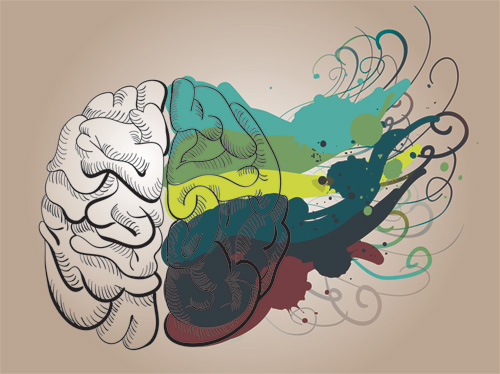Hi friends,
Last week, we learned about core beliefs and how core beliefs can be positive and life-enhancing, and they can also be negative and self-limiting. It’s common to have both types of core beliefs. Did you happen to try on a new pair of glasses to change perspective? Good for you for trying! What was your experience with this? Yup, it can take (quite) a bit of work to change perspective and modify core beliefs, but it’s well worth the effort when it helps to manage stress,adapt to change, and feel better about ourselves.
Let’s explore core beliefs a little more this week. Core beliefs are thoughts. Core beliefs are developed honestly through our experiences, interactions, and learning through life. They are often formed because they serve an adaptive function and successfully helped us manage a particular time in our life. Yet, they can outlive their helpfulness and become unhelpful later in life when our situation has changed. And, now… this may come as a surprise, but thoughts, including core beliefs, may not even be true. What? Yes, you heard me right. It might come as a surprise to hear that thoughts are not facts. Thoughts are mental events formed in response to a situation based on a combination of past learning, self-beliefs, expectations, and attempts at problem-solving. Our mind is thinking all the time. Sometimes loudly sometimes inaudible. But always influencing the way in which we understand and respond to people and situations in our day. Thoughts can lead us to feeling positive and empowering emotions which then lead to choosing positive, healthy actions. Or, thoughts can lead us to feeling negative and limiting emotions and thus to choosing negative, unhealthy actions.
Cognitive Behavioral therapy is based on the premise that thoughts influence emotions which, in turn, influence behaviors. And that unhealthy behavioral patterns can be changed by revisiting the underlying thought(s) and assessing it for its degree of helpfulness and truthfulness. There are some very usual ways that thoughts create problems for us. These are called unhelpful thinking habits (a.k.a. cognitive distortions; thanks to the amazing work of Dr. David Burns). Here are the top 5 I hear about most often:
All-or-nothing thinking: this is thinking in black and white terms. Something either is good or bad, right or wrong, to be done this way or that way; never in between or in shades of grey. This promotes inflexible thinking and “stuckness” E.g., “People who don’t wear face masks are to blame for spreading the coronavirus”.
Fortune-Telling: assuming that something will happen a certain (negative) way in the future, as if you are able to predict the future. E.g., “With these infection numbers rising, we won’t be having Christmas this year”.
Mind-Reading: assuming you know what others are thinking. E.g., “I just know that person looking at me is thinking I’m weak for wearing a face mask”.
Emotional Reasoning: assuming that because something feels negative, it must be negative, or I must be negative. E.g., “I feel so uncomfortable around that person not wearing a mask, there must be something wrong. They must be sick”.
Catastrophizing: assuming that the worse will happen. E.g., “If I get the coronavirus I will get so sick I won’t survive”.
Next week, I’ll write about a few more unhelpful thinking habits, there are at least 10 all together.
The first step in modifying the thought-emotion-behavior connection is just becoming aware of unhelpful thinking patterns. This week, if you have a chance, take some time to sit still with your thoughts. Allow thoughts to come to mind as they are, without trying to change them, judge them, deny or avoid them. Notice any themes, patterns, or assumptions. Which unhelpful thinking patterns show up? Which unhelpful thinking patterns seem to be most problematic for you? With a dab of self-compassion, acknowledge that ALL people fall into unhelpful thinking patterns at some point or another. And that just as all of us learned unhelpful thinking habits, we can unlearn them and replace them with alternative positive, coping thoughts. Lean into acceptance and affirm your courage to take steps towards more positive thinking, feeling, and behaving.
Join me next week to find out how.
stay well,
Melanie
References:
A description and visual about the CBT model: https://www.therapistaid.com/therapy-worksheet/cbt-model-worksheet
CBT Thinking Errors available from: https://www.therapistaid.com/therapy-worksheet/cbt-thinking-errors
https://psychcentral.com/blog/5-ways-to-expand-all-or-nothing-thinking/
Resources:
Core Beliefs: a worksheet for Examining the Evidence: available at: https://www.therapistaid.com/therapy-worksheet/core-beliefs-examining-evidence
A great information sheet on Core Beliefs:
https://www.cci.health.wa.gov.au/-/media/CCI/Mental-Health-Professionals/Depression/Depression—Information-Sheets/Depression-Information-Sheet—12—What-are-Core-Beliefs.pdf
Information on how core beliefs are strengthened by paying attention to evidence that support the negative belief: https://www.psychologytools.com/resource/core-belief-magnet-metaphor/
A list of unhelpful thinking habits and questions to ask yourself to challenge the rationality/truthfulness of the thought: https://www.getselfhelp.co.uk//unhelpful.htm
A little heavier reading (a whole chapter!) on cognitive conceptualization and the definition/assessment of core beliefs: https://beckinstitute.org/wp-content/uploads/2015/11/Basics-and-Beyond-Chp-3-Cognitive-Conceptualization.pdf
Especially for People you work with:
Therapist Aid has a worksheet called “CBT practice exercises” available here: https://www.therapistaid.com/therapy-worksheet/cbt-practice-exercises This could be a handy and helpful worksheet to work through with the folks you spend time with this week. It includes reading through various scenarios, then identifying an alternative rational thought from the negative thought provided. It also prompts people to imagine the more positive emotion and behavior that would result from more rational thinking.
Another Therapist Aid worksheet called “Core beliefs – examining the evidence” (available at: https://www.therapistaid.com/therapy-worksheet/core-beliefs-examining-evidence) is a great worksheet for developing the skills to identify and separate evidence that supports the belief from evidence that refutes the belief. This worksheet is not in plain language, so you may need to modify the language a bit to better suit the person you are talking with.
Lastly, the “Simple CBT model” (https://www.therapistaid.com/therapy-worksheet/simple-cbt-model) offers a simple, visual explanation of the CBT-based relationship between situation-thoughts-emotions-behaviors. The visual symbols presented can provide a common language between you and the people you work with in identifying and modifying the relationship between thoughts, emotions, and behaviors.

